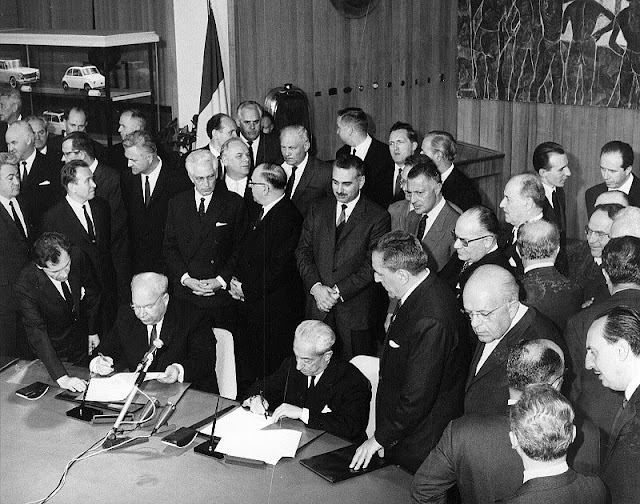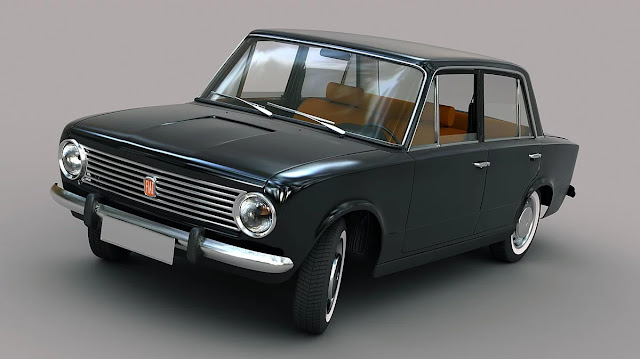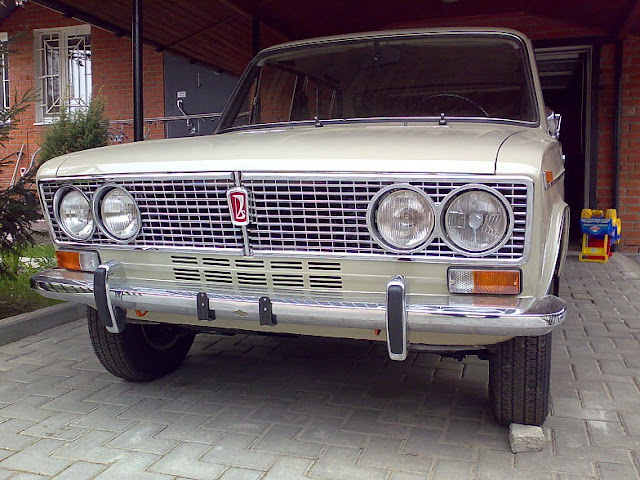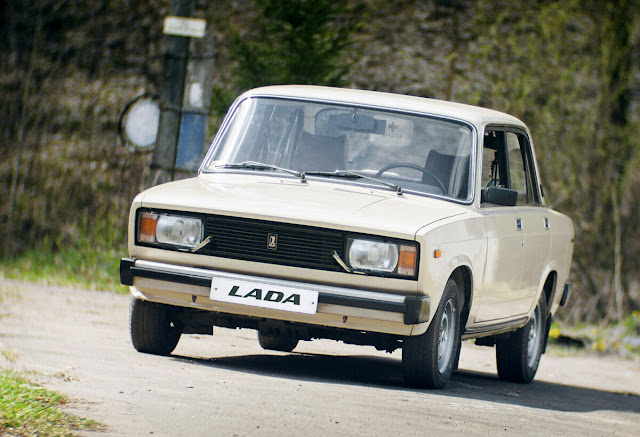 |
| How the style of the AvtoVAZ emblem has changed over the years. |
On July 20, 1966, a Soviet government decree was signed on the construction of an automobile plant in the city of Togliatti. Since then, this date has been considered AvtoVAZ's birthday.
The company has become one of the largest passenger car manufacturers in Europe. Over the entire history of the automobile plant in Togliatti, more than 29 million cars of 50 different serial models were assembled.
We suggest recalling how it all began 53 years ago, when iconic VAZ models appeared that had a significant impact on the development of the automobile plant and the country.
 |
| On May 4, 1966, Turin Italy signed a protocol on the participation of the FIAT concern in the creation in the USSR of an auto-building enterprise (VAZ) |
The birth of the auto giant
 |
| The most affordable car was Moskvich |
Soviet citizens could buy cars back in the early 1950s, but then the choice was small: the most affordable passenger car was the "Moskvich", the most expensive - the "Victory". The number of produced "Moskvich" was not enough to cover demand.
 |
| Zaporozhets was the most affordable Soviet car |
The country needed a truly “people's car”. At some time even "Zaporozhets" claimed this role. However, many segments of the population did not like the car belonging to the subcompact class. As a result, the government proposed the construction of a new automobile plant, which could produce more than half a million passenger cars a year and thus satisfy the country's automobile boom.
 |
| In 1966, FIAT introduced its new FIAT 124, recognized as the “Car of the Year" |
To accelerate the creation of such an enterprise, it was decided to attract foreign specialists. The choice fell on the Italian concern FIAT, whose cars were popular in Europe. In particular, in 1966, the concern introduced its new FIAT 124 model, recognized as the “Car of the Year." The production of this particular machine was to be mastered in the USSR.
 |
| Construction of a new automobile plant in the city of Tolyatti |
The decision to build a new automobile plant in the city of Tolyatti was officially taken on July 20, 1966. The construction became grandiose - equipment for the new enterprise was manufactured at 844 machine-building plants of the USSR, at 900 plants in other countries, including Germany, Italy, Great Britain, and France.
Six years were allocated for such a large-scale construction, but the enterprise was erected in record time - for three and a half years. Already in 1970, the first six VAZ-2101 Zhiguli cars rolled off the VAZ conveyor.
The first "penny" in the bank models
The first model was created on the FIAT 124 platform, but we can say that it was already a different car. Composed entirely of local components, it had more than 800 improvements compared to the prototype, which were designed to adapt the car to local roads and climate. In particular, the body was strengthened, the ground clearance was increased. In addition, the VAZ-2101 has acquired a new, more powerful, 1.2-liter carburetor engine.
 |
| The VAZ-2101, or “penny,” as the car was nicknamed by the people |
The VAZ-2101, or “penny,” as the car was nicknamed by the people, not only reduced the car deficit in the country, but turned upside down the idea of Soviet motorists about cars. The high level of comfort, good dynamics, ease of control, efficiency allowed the first car of the Volga Automobile Plant to become a truly “people's” car in the shortest possible time.
VAZ-2101 and its modifications were produced until 1988, during which time about 4.8 million cars were produced. But today, three decades after the last penny came off the assembly line, many of them are in excellent condition running along the roads of the country and abroad. By the way, since 1971, VAZ-2101 cars were delivered abroad. It was then that the car received the export name LADA, while in the domestic market the car was known as the “
Zhiguli” (by the name of the mountains).
Workhorse “Two”
The VAZ 2102 is a licensed version of the Fiat 124 Familiare, with many differences similar to the base model of the VAZ-2101. The first VAZ-2102 car came off the assembly line of the Volga Automobile Plant in 1971. Then, after the start of production of the VAZ-2104 “Four” successor in 1984, both cars were produced for another year at the same time until the “Two” was removed from production in the summer of 1985.
 |
| VAZ 2102 is a licensed version of the Fiat 124 Familiare |
The new model was largely unified with the base VAZ-2101 sedan. The dashboard and driver’s workplace are identical to those of the VAZ-2101. The edge of the tailgate is brought to the bumper and is flush with the floor, which simplifies loading and unloading operations. The solid rear seat is folding, which allows you to get a horizontal cargo area. The license plate is located on the rear door, the taillights are located vertically.
Reliable “triple”
In 1972, VAZ launched a more powerful version of the Zhiguli, the VAZ-2103“triple” , in comparison with the VAZ-2101. (But a full-fledged production of “triples” began in early 1973 - the first 1,500 cars produced in November-December 1972 were equipped with a passenger compartment VAZ-2101 due to problems with the start of production of interior design details and wore the VAZ-2103B index (B-temporary)) The basic 72-horsepower VAZ-2103 engine allowed reaching a speed of 100 km / h in 15 s.
 |
| In 1972, VAZ launched the production of a more powerful version of the Lada compared to the VAZ-2101 - the VAZ-2103 |
In addition, this model was distinguished by the presence of a vacuum brake booster and automatic adjustment of the gap between the rear brake pads and the drum, a “sports” instrument panel with a tachometer.
The differences in the decoration of the 2103 cabin from the VAZ-2101 were significant: the space above the head was increased by 15 mm, and the distance from the ceiling to the seat was 860 mm. The instrument panel in which the clock and tachometer are installed has been changed.
VAZ 2104 station wagon ”Four”
VAZ-2104 is a rear-wheel drive passenger car with a station wagon body. Designed at the Volga Automobile Plant. In production since 1984
 |
| VAZ-2104 is a rear-wheel drive passenger car with a station wagon body. |
Serial production of the VAZ-2104 car was launched at the Volga Automobile Plant in 1984. The new model was produced in parallel with the VAZ-2102 car of the same class until 1985. When creating this model, designers were guided by an important feature of that time, the creation of a new model with minimal production costs and maximum consumer effect. Therefore, the VAZ-2105 model was taken as the basis. After lengthening the roof, stampings appeared to reinforce stiffness. Such a body structure made it possible to place a long trunk on the roof, which was not recommended to be overloaded, since the estimated stiffness of the station wagon body is much lower than that of a sedan
VAZ-2105 progressive ”Five”
VAZ-2105 is the basic model of a deeply modernized family, which includes the 2104 station wagon and the 2107 luxury sedan.
 |
| The VAZ-2105 model in its design almost corresponded to European fashion of the early 1980s |
The VAZ-2105 model in its design almost corresponded to European fashion of the early 1980s. This allowed the model to be sold in several European countries for many more years. Although in Europe, such rear-wheel drive four-door five-seater sedans already in the 70s began to lose ground to front-wheel drive models.
Popular "Six": four million cars
The second most popular model in the history of AvtoVAZ is the ”Six” (VAZ-2106). Its serial production began in 1976 and continued until 2006. In total, more than 4 million ”sixes” were produced.
 |
| The second most popular model in the history of AvtoVAZ is the Six (VAZ-2106) |
The base for the VAZ-2106 was the 1972 FIAT 124 Speciale. The ”Six” had a relatively powerful 1.6-liter engine with a capacity of 75 liters. from. and developed a speed of up to 152 km / h.
It was a four-door, five-seater model with a four- or five-speed gearbox and a sedan-style body. In the decoration of the new car, modern details have appeared: a plastic edging of the headlights, a radiator grill, license plate light. Soundproofing was improved in the salons, the front seats were equipped with head restraints, and the seats were equipped with bumps.
VAZ 2107 luxury "Seven"
VAZ 2107 - 4-door 5-seater rear-wheel drive model with a 5-speed gearbox and a body type "sedan". It was created on the basis of the VAZ 2105. Serial production of the VAZ 2107 began in 1982.
 |
| VAZ 2107 - 4-door 5-seater rear-wheel drive model with a 5-speed gearbox and a body type "sedan". |
The external design of the VAZ 2107 differed from the VAZ 2105 in the following: the shape of the hood, rear block headlights and trunk was changed. The radiator grill became chrome plated and acquired a large area. Chrome bumpers appeared on the bumpers.
The VAZ 2107 saloon also differed from the VAZ 2105 saloon: more comfortable anatomical seats with integral head restraints were installed in front, the dashboard was changed, where new speedometers with markings up to 180 km / h and a tachometer were installed. Deflectors for supplying cold air have also been added. The trim and seats were significantly improved, as a result of which the VAZ 2107 salon acquired a more modern look.
VAZ 2108 chisel "Eight"
VAZ-2108 - a small class car with front-wheel drive and a transverse engine. Produced by the Volga Automobile Plant. Not currently in progress. Its successor is released - 2113, which looks different from 2108 in a modified front end shape (wings, hood, optics), other bumpers, plastic door sills and a spoiler on the rear door
 |
| VAZ-2108 - a small class car with front-wheel drive and a transverse engine. |
The VAZ-2108 car first appeared in 1984. This model with a three-door hatchback body was truly a landmark event not only for the Volga Automobile Plant, but also for domestic car enthusiasts. It was proposed to name it in the domestic market - "Sputnik", but the name did not take root and in the end, the export - "Samara" was established. The VAZ-2108 Sputnik / Lada Samara model marked the beginning of the mass production of front-wheel drive cars in the country. The car turned out, of course, more reliable in operation, safe and economical in comparison with the classic "Lada". The corrosion resistance of the body has also become objectively better.
VAZ 2109 Lada Sputnik "Nine"
Lada Sputnik (Samara) - a five-door front-wheel drive hatchback. Developed and mass-produced at the Volga Automobile Plant from 1987 to 2004. It is assembled in Ukraine (with an engine of 1600 cc). With the rear seat folded down, the car transforms into a utility-passenger version similar to a station wagon.
 |
| Lada Sputnik (Samara) - five-door front-wheel drive hatchback |
Previously, Sputnik was equipped with in-line four-cylinder eight-valve carburetor gasoline engines with a volume of 1100, 1300 and 1500 cc. Since 1994, 4-cylinder 8-valve gasoline engines VAZ-2111 1,500 cc began to be installed on these machines. with distributed fuel injection. The feature of the 8-valve engine is 1.5 liters - when the timing belt breaks, the pistons do not reach the valves. On some cars, a VAZ-415 rotary piston engine was installed, which had great power (140 hp), but a small resource.
The car was repeatedly restyled: the “low” dashboard was replaced by “high” and then “europanel”.
Since 1990, an updated modification of the “nine” VAZ-21093 has left the assembly line. Modernization, first of all, touched the body. The car received a short wing, as well as changes to some parts of the front and radiator. This was done in connection with the unification of the model with the VAZ-21099 sedan. Since the beginning of the nineties, cars in the "Lux" configuration began to be produced. They were equipped with a more modern dashboard with a tachometer and trip computer. A new engine model with a distributed fuel injection system has also appeared. In addition, some cars came off the assembly line with a pre-installed anti-theft system, power door locks and power windows. Also changed the appearance of the rear side windows, steering wheel, etc.
VAZ-21099 Satellite / Samara Forma
VAZ-21099 Sputnik / Samara Forma is a four-door sedan of the Volga Automobile Plant - the latest model of the Samara family of the first generation.
 |
| VAZ-21099 Sputnik / Samara Forma is a four-door sedan of the Volga Automobile Plant |
The VAZ 21099 model has been produced since 1990. “Ninety-ninth” is essentially a “nine” with a four-door sedan body. The final model of the Samar family differed from its older sisters in overall length, which, due to an increase in the rear overhang, increased by 200 mm compared to other cars in the family. Prior to the release of cars of the LADA 110 family, this model was the most prestigious and popular.
In this model, the original radiator trim, hood and front fenders were made without a plastic “mask”, and the interior was distinguished by a new panel (popular name “high”) with a tachometer in the instrument cluster. Subsequently, these decisions passed to the entire Samara family.
Niva: always ready for difficulties
In 1977, the first VAZ-2121 Niva left the assembly line at the Volga Automobile Plant. This model ushered in a new era in the history of all-wheel drive cars. On off-road vehicles of those times, the main driving axle was the rear, and the front was connected at the exit on the road. "Niva" at any time is ready to overcome difficult areas, since all-wheel drive is always involved on it. For the first time on an SUV of this class, “passenger” attributes were used, such as a supporting body, an independent front suspension, and front disc brakes. Also, unlike the SUVs of that time, Niva received a high-speed engine.
 |
| VAZ-2121 "Niva" was the first completely original car developed at the Volga Automobile Plant. |
Well, and perhaps the most remarkable fact: the VAZ-2121 Niva was the first completely original car developed at the Volga Automobile Plant.
Niva VAZ-2121 is the most exported Soviet and Russian car. There were times when up to 70% of Niva was delivered abroad. Right-hand drive modification of the Niva was even sold in Japan, the UK and other countries with left-hand traffic.
Since 1977, about 2.5 million VAZ-2121 SUVs have been produced. Over the course, Niva went through several cycles of modernization; in 2005 it changed its name to LADA 4x4. The most modern modification is Urban. The car received air conditioning, power accessories, plastic bumpers in body color, metallic paint, alloy wheels, a more comfortable interior. At the same time, permanent four-wheel drive and a transfer case with a reduction gear are preserved. Updates are ongoing. For example, in 2016, gas-filled shock absorbers and maintenance-free front hub bearings appeared on the LADA 4x4.
 |
| Niva Urban |
New era: the latest models with Soviet roots
After the collapse of the Union, the Volga Automobile Plant was in serious condition, like many enterprises in the country. But by the mid-1990s, the company managed to establish its own car production.
 |
| The first model of AvtoVAZ in the post-Soviet era was the "ten" - the VAZ-2110 |
The first model of AvtoVAZ in the post-Soviet era was the "ten" - the VAZ-2110. Due to the difficulties of the transition period, she came out with a delay of three years, only in 1995. In the Russian market, this car could well compete with popular foreign cars of the time, such as the Daewoo Nexia, Audi 80 or even the Opel Astra. Almost immediately, the so-called “eleventh” model was released, and a few years later AvtoVAZ produced the VAZ-2112. In 2007, the Priora, the last AvtoVAZ model with Soviet roots (with the exception of LADA 4 × 4), left the assembly line.
 |
| Priora, the last AvtoVAZ model with Soviet roots |
In 2008, during the period of economic crisis, AvtoVAZ established cooperation with Renault. This served as an incentive to receive financial support from the Russian government and opened a new page in the history of the enterprise. In partnership with the French concern, new LADA models were created: Largus, Granta and Kalina of the second generation.
Recent History: X-Time
New times have required new cars. AvtoVAZ, combined with Renault and Nissan, needed a new platform that could compete with European and Korean popular models. So Vesta appeared, which became the basis of the latest history of AvtoVAZ.
 |
| LADA Vesta |
Vesta’s birthday can be considered June 10, 2010, when the idea of a new AvtoVAZ platform was introduced, which should ensure a change in model line by 2020. The peculiarity of this machine is not only in design. The appearance of LADA Vesta significantly increased the brand's image: according to statistics, today every third buyer of LADA Vesta transfers to it from a car of another brand.
 |
| VESTA SW CROSS |
The new models LADA Vesta and LADA XRAY, which were released in 2015, were a real breakthrough for the brand. Used X-graphics is a distinctive feature of modern AvtoVAZ. The style was developed by the factory’s design team, led by design director Steve Mattin. The main accents of the new LADA style are a clearly defined X-graphic, combining headlights, a radiator grill and lower air intakes, reinforced by two individual chrome elements of the letter X
 |
| Lada XRAY |
After the start of production of both models, AvtoVAZ extends the new LADA style to other existing and promising models. A more understandable and modern lineup is being formed. Each consumer segment has its own models: the LADA Granta family is low-cost cars, Vesta and XRAY are more expensive cars, and two highly specialized models are LADA 4 × 4 and Largus.
 |
| Lada Kalina |
The most popular LADA by the results of sales for the first half of 2019 was LADA Granta - almost 64 thousand cars of this family found its customers, which is 40% higher than last year. LADA Vesta took the second line of the rating: more than 55 thousand cars were sold in half a year.
 |
| Lada Granta hatchback |
History has repeatedly proved that the production of even the most successful cars comes to an end. Once the conveyor will stop for Vesta, as it once was for the popular “penny”. But AvtoVAZ does not intend to stop - until 2026, the plant promised to launch eight new models in a series.


























